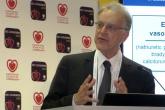Conference Coverage

LCZ696 surpasses enalapril for heart failure
Key clinical point: Substituting LCZ696 for enalapril in heart failure patients was linked with significant improvements in survival, heart...

A combination of a new drug, sacubitril, a neprilysin inhibitor, and the angiotensin receptor blocker valsartan has been approved for treating heart failure, providing what experts are describing as a major advance in the treatment of heart failure.
The approval, announced by the Food and Drug Administration on July 7, was based on the results of the PARADIGM-HF study of about 8,400 patients with class II-IV heart failure and an ejection fraction of 40% or less. The study showed that the combination reduced the risk of cardiovascular death and hospitalization for heart failure by 20% and reduced the risk for all-cause mortality by 16%, compared with enalapril, with a favorable adverse event profile.
The approved indication for sacubitril-valsartan is to “reduce the risk of cardiovascular death and hospitalization for heart failure in patients with chronic heart failure [New York Heart Association class II-IV] and reduced ejection fraction,” according to the prescribing information. The indications section includes the statement that it “is usually administered in conjunction with other heart failure therapies, in place of an ACE inhibitor or other ARB [angiotensin II receptor blocker].” It is contraindicated for use with ACE inhibitors, and when patients on an ACE inhibitor are switched to this drug a washout period of 36 hours before starting treatment is recommended.
Previously called LCZ696, the combination tablet formulation will be marketed by Novartis as Entresto, and will be available in three dosage strengths of sacubitril-valsartan: 24/26 mg, 49/51 mg, and 97/103 mg; in published studies of the combination, these doses are referred to as 50 mg, 100 mg, and 200 mg, respectively. The target dose is 97/103 mg twice a day.
“Many of us see this as a real sea change in heart failure management; we’re all eager to start using this new medicine in our patients, and I think clinicians will very rapidly get a feel for this drug,” Dr. Scott D. Solomon, professor of medicine, Harvard Medical School, Boston, and one of the authors of the study, said in an interview. Referring to the trial results, he noted that for at least 10 years, there has not been a new drug for heart failure that has had this impact on mortality, “so this is really quite an extraordinary finding.”
The availability of a new drug class, a neprilysin inhibitor, “opens up a new chapter in our treatment of heart failure,” said Dr. Mariell Jessup, professor of medicine at the University of Pennsylvania, Philadelphia, who was not involved in the study. “I’m very excited that we now have this new drug for use in our patients,” she said, pointing out that with the exception of ivabradine (Corlanor), approved in April, there has not been a new type of drug approved for heart failure in a long time.
Neprilysin is an endopeptidase that degrades several endogenous vasoactive peptides. Sacubitril “inhibits the breakdown of natriuretic peptides, among other vasoactive compounds, so the drug simultaneously blocks one of the neurohormonal systems that is abnormally activated in the setting of heart failure, and it also augments one of the neurohormonal systems that can be beneficial in patients with heart failure,” said Dr. Solomon, who is also director of noninvasive cardiology at Brigham and Women’s Hospital, Boston.
In PARADIGM-HF, conducted to determine if sacubitril-valsartan was superior to treatment with an ACE inhibitor, the recognized standard treatment for heart failure, a composite of death from cardiovascular causes or a first hospitalization for heart failure (the primary outcome), was 21.8% among those randomized to the combination vs. 26.5% of those on enalapril after a median 27-month follow-up, a highly statistically significant difference that represented a 20% reduced risk over the comparator (N. Engl. J. Med. 371:993-1004). A 20% reduced risk over enalapril was seen for the two components individually in the study, which was stopped early because of the magnitude of the effect over enalapril at a dose of the ACE inhibitor that the investigators pointed out had been shown to reduce mortality, compared with placebo.
Hypotension and nonserious cases of angioedema were higher among those on sacubitril-valsartan, while renal impairment, hyperkalemia, and cough were higher in the enalapril-treated patients.
As with ACE inhibitors, there is a small risk for angioedema, and while the number of cases was low in the study, physicians need to be aware of this issue, Dr. Solomon said. “To use this effectively, patients who are on ACE inhibitors or ARBs will need to be stopped, given 36 hours to wash out, and then started on this new agent,” he said.

Key clinical point: Substituting LCZ696 for enalapril in heart failure patients was linked with significant improvements in survival, heart...

